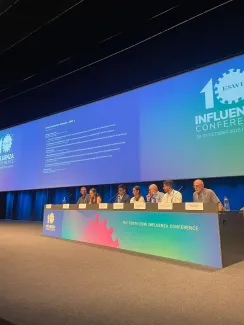The Anatomy of the Next Influenza Vaccine
Since its inception in the 1940s, influenza vaccination has remained our most effective tool against flu pandemics. Over the decades, vaccine formulations have evolved – from early monovalent egg-based vaccines to the inactivated quadrivalent intramuscular vaccines most commonly used today. What might the next generation of influenza vaccines look like? The parallel session Future Vaccination Strategies – Part 1 offered a compelling glimpse into the directions researchers are taking.
Starting from the mucosal layer
Professor Michael Schotsaert at the Icahn School of Medicine at Mount Sinai, United States, aims to stop influenza at the mucosal layer. By combining a nanoemulsion (NE)-based adjuvant with an RNA-based RIG-I agonist (IVT DI), his team has developed a new combination adjuvant (NE/IVT) for intranasal vaccination. When tested in guinea pig models, NE/IVT-adjuvanted vaccines outperformed AddaVax-adjuvanted vaccines, showing stronger mucosal and serum antibody responses and less pathology. The group also observed reduced viral shedding and transmission in the intranasal vaccine group, suggesting that targeting mucosal immunity could disrupt both initial infection and onward transmission.
Stability is key
Influenza experiences high rates of antigenic drift, and as such, vaccine formulations must be updated annually. Dr Giuseppe Palladino at CSL is working to improve vaccine durability by incorporating neuraminidase (NA) into influenza vaccine formulations using a self-amplifying (SA) mRNA platform. His team compared vaccines containing haemagglutinin (HA) only, NA only, and a combined HA and NA constructs in a ferret prime-boost model. While day 1 post-infection results were similar, a significant reduction in viral load, viral shedding, and morbidity (as measured by body weight loss) was seen at five days post-infection. This highlights NA’s potential for long-term protective effects.
Towards a universal flu vaccine
Daryl Lee from Professor Sylvie Alonso’s lab at the National University of Singapore has an ambitious goal: to build a universal influenza vaccine. He believes the answer may lie in using the influenza A virus matrix protein 2 ectodomain (M2e)-based vaccine to target conventional type 1 dendritic cells (cDC1) by leveraging the Clec9A antibody. When the group tested this targeted Clec9A-M2e construct in mouse models, they found durable humoral and cellular responses, even six months post-vaccination. Remarkably, both young and aged mice showed significantly enhanced immunity regardless of prior flu exposure, positioning cDC1 as a promising target for future vaccine development.
As research advances on multiple fronts, the future of influenza vaccination is rich with possibilities. To explore emerging strategies and innovations further, be sure to attend the second part of this series: Future Vaccination Strategies – Part 2, on Wednesday, 22 October, from 11:00 to 12:30.
Find more related content on the virtual platform:



